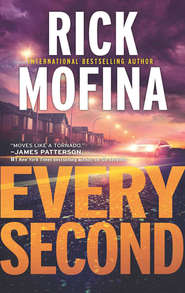По всем вопросам обращайтесь на: info@litportal.ru
(©) 2003-2025.
✖
Whirlwind
Автор
Год написания книги
2019
Настройки чтения
Размер шрифта
Высота строк
Поля
Kate showered, dressed and bit into a stale bagel for breakfast as she went online and searched the long list of emergency shelters across the Metroplex. After making notes on those located near the flea market, she went to her car, determined to deliver a solid story today.
I’ll prove that I’m as good as the others.
Early-morning traffic was manageable. Thankfully she was familiar with her destination. First, she went to the flea market, where she’d learned that security had been tightened. For safety reasons, access was now limited to officials and media with valid accreditation.
After Kate showed her Newslead ID, she headed across the debris-covered grounds to the Saddle Up Center, concerned that she was not going to find Jenna and Cassie Cooper here.
Amid the barks of dog teams, search-and-rescue efforts were still continuing before the operation evolved into debris removal, Fire Captain J. B. Langston told her.
“We’ve been going all night and we haven’t recovered a baby so far. We’ve extracted more injured survivors and fatalities. Several children and more adult victims, but no baby,” Langston said. “You know that people were swept up into the winds. I heard our guys found one of the center’s vendors in a tree, seven miles from here.”
“Yeah, that was terrible. I read that in an Associated Press story,” Kate said. “Captain, do you have any idea where shelter survivors and their families were taken?”
“Try Rivergreen Community Hall. There are a few others but Rivergreen’s your best bet.”
It was a short drive, some two miles south. The community hall, a square one-story building, had been designated an emergency shelter for the area.
Emergency vehicles, buses, news vans, along with trucks delivering food, water and other aid, filled the parking lot. Clearly, this shelter had been operating nonstop through the night, Kate thought as she entered.
Inside, the hall droned with activity. Banners from a Retirement & Appreciation banquet, planned for last night, waved like a memory over rows of cots and mats occupied by people recovering from the storm. They filled the large central area. Some were sleeping, some were huddled comforting others. Some were reading government application forms or talking on cell phones. Although spotty, there was service.
Tables staffed by emergency workers, aid agencies, church groups and other volunteers lined the walls. They offered medical help, advice on insurance claims and counseling. Signs pointed to showers, extra toilets, laundry facilities, toiletries, towels, clothing and toys. There was a station to donate blood. At one end of the hall, people lined up for hot food. Several large TVs were turned to storm news and there were computers with internet service donated by local companies.
Kate came to a heartbreaking sight in one corner: a Missing/Displaced Persons sign. Under it were a few dozen photographs of women, children and men of all ages hastily taped to the wall like a patchwork quilt of hope. A few had little notes with contact information attached to them.
The effort was run by the Missing Person Emergency Search System—MPESS—a national agency based in Washington, D.C. When Kate arrived, several staff members at three tables were using laptops, maps and cell phones as they took information from anguished people.
A bleary-eyed man in his late forties with salt-and-pepper hair turned to her. He was wearing a navy MPESS polo shirt. The ID tag hanging from his neck said Frank Rivera, Supervisor.
“Sure, I got a minute,” Rivera said after Kate had requested someone with the group speak to the press. “What do you need?”
She asked for a rundown on the search system, how it was helping to find missing people, because she’d thought that the process was already being handled by local relief workers.
“That’s correct,” Rivera said, “we’re helping local groups and the Dallas Police Department and Sheriffs for surrounding counties. We’re coordinating their ‘missing persons’ work and their database. We’re an experienced national nonprofit agency, with expertise in this area of crisis response. We’ve got retired cops, federal agents and investigators. The federal Justice Department and FEMA arranged for us to come. Once they got the airports running, most of our teams flew in overnight from all over the country. We’re set up at emergency shelters at all the hardest-hit communities.”
Вы ознакомились с фрагментом книги.
Приобретайте полный текст книги у нашего партнера:
Приобретайте полный текст книги у нашего партнера:











